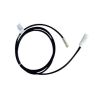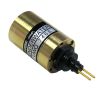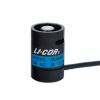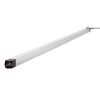LI-COR LI-193 Underwater Spherical PAR Sensor
Features
- Uses computer-tailored filter glass to achieve the desired quantum response
- Calibration is traceable to NIST
- Features corrosion-resistant, rugged construction for use in up to 350m depths
- Free ground shipping
- Expedited repair and warranty service
- Lifetime technical support
- More
Overview
The LI-COR LI-193 Underwater PAR Sensor gives an added dimension to underwater PAR measurements as it measures photon flux from all directions. This measurement is referred to as Photosynthetic Photon Flux Fluence Rate (PPFFR) or Quantum Scalar Irradiance. This is important, for example, when studying phytoplankton, which utilize radiation from all directions for photosynthesis. The LI-193 features a high sensitivity optical design and compact, rugged construction for use in freshwater or saltwater and pressures up to 493 psi or 350 meter depths.
- Absolute Calibration: +/-5% in air traceable to NBS
- Sensitivity: Typically 7 uA per 1000 umol s-1 m-2 in water
- Linearity: Maximum deviation of 1% up to 10,000 μmol s-1 m-2
- Stability:< +/-2% change over a 1 year period
- Response Time: 10 us
- Temperature Dependence: +/-0.15% per C maximum
- Angular Response:< +/-4% error up to +/- 90 degrees from normal axis
- Azimuth:< +/-3% error over 360 degrees at 90 degrees from normal axis
- Detector: High stability silicon photovoltaic detector (blue enhanced)
- Sensor Housing: Corrosion resistant metal with acrylic diffuser for both saltwater and freshwater applications
- Waterproof: withstands 500 psi pressure (350 meter depths)
- Size: 6.1cm Dia. globe; 3.18cm dia. housing; 10.7cm H
- Weight: 142g
- Mounting: (3) 6-32 holes are tapped into the base for use with the 2009S Lowering Frame or other mounting devices
- Cable: Requires 2222UWB Underwater Cable
In The News
Sustainable Data Collection: Climate Monitoring in the Caribbean
Environmental monitoring in the Caribbean may be essential, but it has also historically been placed on the back burner. Albert Jones, Instrumentation Officer for the Caribbean Community Climate Change Centre (CCCCC), explains, “Data collection itself is not what is considered one of those sexy activities where you can easily get funding.” Still, monitoring the water surrounding island nations is necessary to protect residents and the environment. The CCCCC works to establish environmental monitoring networks and systems in the Caribbean. One aspect of Jones’ work centers around data buoy instrumentation and deployment,—equipment that will be used to support Ecoforecasts for Coral Health Monitoring and to provide valuable environmental data to the public.
Read MoreExploring the Link between Biodiversity and Species’ Recovery After Oil Spills in the Gulf of Mexico
When the Deepwater Horizon oil spill happened in 2010, media outlets were flooded with images of oil-covered birds and dead jellyfish. Wildlife populations of many kinds plummeted. Fishing and tourism plunged with them. The Deepwater Horizon spill was considered one of the largest environmental disasters in American history. Years later, populations were still struggling and oil was still washing up on Gulf coast beaches.
Read MorePlankton Portal enlists public to classify thousands of zooplankton images
Zooplankton drifts through the ocean, often ignored by the public in favor of more charismatic marine organisms farther up the food chain. A new crowdsourced project aims to change that, giving anyone a closer look at small and intricate zooplankton. PlanktonPortal.org features 900,000 high resolution images of zooplankton and tasks the public to identify them as part of data processing for a collaborative study, based out of the University of Miami Rosenstiel School of Marine and Atmospheric Science. Researchers hope the project will tell them more about zooplankton behavior, grouping and interaction.
Read More



















